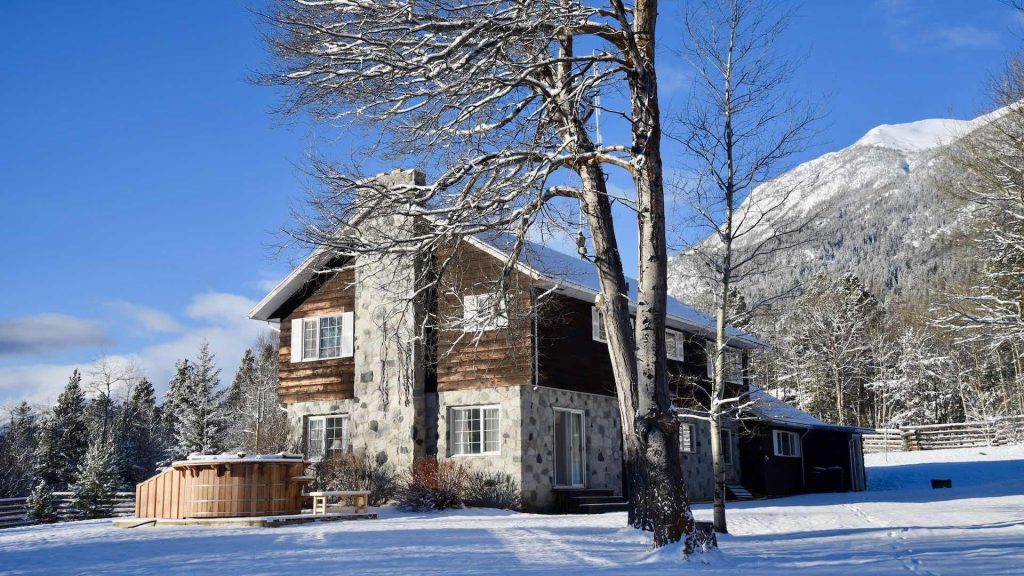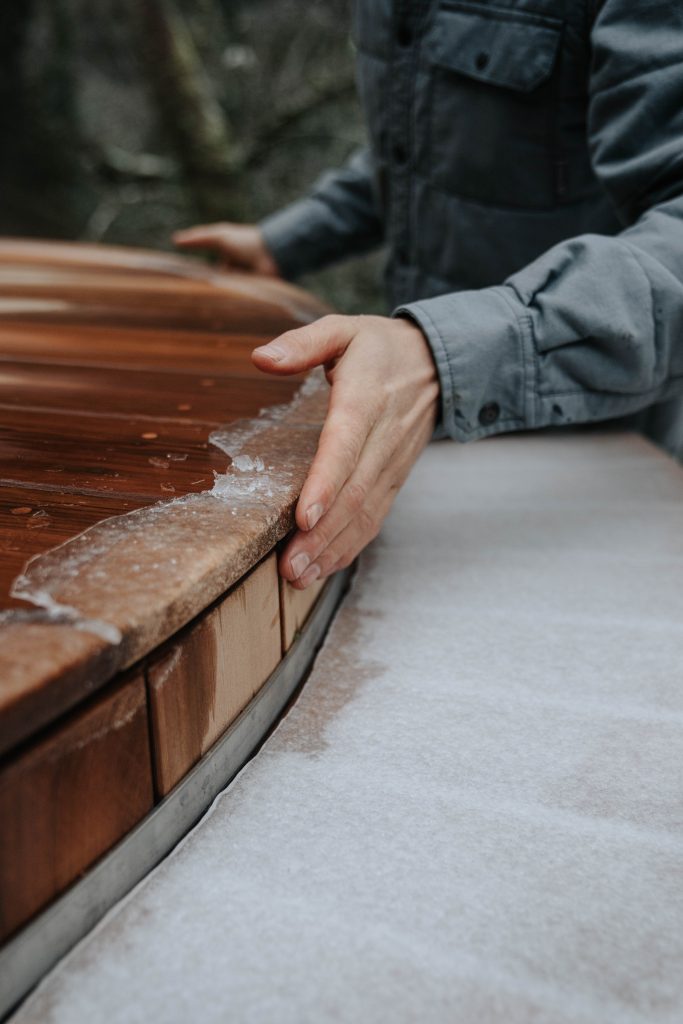Whether you’re dreaming of hot soaks as the snow falls around you or you’re planning to put your tub into hibernation for the winter, a few simple tips will allow you to store and use your cedar hot tub in winter.
Our Cedar Barrel Hot Tubs and Cedar Soaker Tubs can be enjoyed in winter with the help of an insulated hot tub cover and a bit of extra care.
Here’s what you need to know about how to preserve the life of your tub as the temperatures drop.


How to Winterize your Cedar Hot Tub
If you live in a cold climate, you’ll need to take steps to protect your cedar hot tub.
It’s important to avoid allowing your tub to freeze when full of water as this puts excessive pressure on the wood–and you’ll be left with an unwieldy block of ice to deal with. A few inches of ice on the surface can be easily melted by lighting a fire or turning on your electric heater, but if your entire tub freezes there is a higher risk of permanent damage.
The key to winterizing your hot tub is to drain water from any small parts that hold water when not in use. An insulated equipment box can be helpful to protect your heater, pump and other equipment from freezing and damage in harsh weather.


Do you need to drain your cedar hot tub before it freezes?
If you don’t plan to use your hot tub at least once a week, your best bet is to drain the tub and refill it as needed. Keep in mind that you will need to ensure your water source doesn’t freeze, so you may want to install a frost-proof pipe if you don’t already have one.
Our cedar hot tubs are built to withstand northern winters but if you live in an extremely cold climate you may want to consider draining your tub for the entire cold season. The energy requirements to keep the tub from freezing can become prohibitive and it can be dangerously cold to get in and out of the tub.
How cold is too cold? That depends on your personal preferences but below -30 degrees, keeping your tub safe for bathing becomes challenging though not impossible.
In situations where you’re not planning to use your hot tub over winter but don’t have a readily available water source, it is possible to leave your hot tub filled, however, you’ll need to take precautions to prevent damage to your tub. One option is to secure a partially inflated inner tube to the bottom of the tub. Alternatively, you can secure several empty plastic milk jugs to the bottom of the tub. This will take pressure off the base and walls of the tub as the water freezes and expands.
How to drain your tub when not in use
When emptying your tub for the entire winter, let your tub drain and wash the inside with a soft-bristled scrub brush and mild soap, working gently with the grain to maintain a smooth surface on the wood. Rinse well, then add a couple of inches of clean water to the tub. If it’s likely that the water will melt and sit for a while before you use it next, you may want to add an algaecide to the water to prevent algae growth.
Replace the hot tub cover and secure it tightly to ensure it doesn’t blow off in a storm. To minimize weathering, you may also want to cover the entire hot tub with a tarp, though this isn’t essential.
The best time to drain your hot tub for winter is when there is a light frost so that the moisture freezes in the wood. If the wood dries out completely, it may shrink creating leaks. Fortunately, if this happens you can always reseal it again in the spring following the same swelling process you used when you first assembled and filled your tub.
In addition to draining your tub, you’ll need to drain and properly store any pumps, pipes, filters and electrical components. Be mindful that any low points that hold water in your system will be quick to freeze, so make sure to completely drain the water. A reverse wet/dry vacuum can be helpful for this. If you have a ball valve on your drain, it’s best to insulate it to prevent freezing.
Always take care to drain water away from the tub to avoid allowing ice to form around the base, and if you’re draining the tub in freezing conditions beware of slipping hazards!


How To Use a Cedar Hot Tub in Winter
If you plan to use your hot tub frequently throughout the winter, you should follow the usual steps for proper cedar hot tub maintenance, always leaving a few inches of water in the bottom after draining between uses. Allowing this small amount of water to freeze will actually help to protect the integrity of the tub.
How to use an electric-heated hot tub in freezing temperatures
If you have an electric hot tub, you simply need to maintain the water temperature above freezing and set your pump to run continuously to ensure water is constantly circulating through the pipes. An equipment box is a good idea to protect your electrical equipment from the elements.
Beware that in case of power outages you may still run the risk of freezing, so it’s important to have a backup generator or a backup plan.
In the event of a brief power loss during freezing conditions, you can place a battery-powered 100-watt lamp or small heater inside your equipment box. Monitor the heater or lamp and ensure it is not too close to any surfaces, which could cause fire hazards or damage from excessive heat. The heater or lightbulb will help prevent the equipment from freezing for a short amount of time, however, if the loss of power is prolonged, the tub will require draining as well.
Can you use a wood-fired hot tub in the winter?
While it will require more time and wood than usual to heat your water, a wood-fired heater is a great way to enjoy your cedar hot tub through the winter. Hot-burning hardwoods like oak, sugar maple or apple are ideal choices to get the most heat value from your firewood.
If you don’t plan to use your hot tub at least once a week, it’s best to drain and refill the tub as needed. If you plan to use your tub more frequently you have a few options to prevent your tub from freezing between uses. You can keep a small fire going or reheat the tub every few days or up to a week, depending on the temperature. Alternatively, if you have access to electricity you can prevent ice from forming with a trough heater or stock tank de-icer.
For external Chofu woodstoves, make sure to fully drain the heater between uses, whether you are draining your hot tub or not. When keeping your tub filled, plug the thru-wall tub ports from the inside of your tub then remove the drain plug at the back of the woodstove to let the water fully drain. When you’re ready to use your tub again, plug the heater and unplug the thru-wall ports before starting your fire.
Submersible stoves are ideal for cold climates. As long as you take care to drain the stove when draining the entire hot tub you should be able to use your submersible woodstove all winter long.
Using your tub for the first time after winter
If you’ve drained your hot tub for the winter, simply drain the small amount of water from the bottom, clean the inside of the tub well and fill it as usual.
In the event your entire hot tub has frozen, it’s safest to allow the ice to melt in the spring rather than using your heater. It is possible to melt the ice with a submersible wood-fired heater, but be sure to continually add water as the ice melts away from the stove as the fire can create excessive heat and melt the aluminum that gets exposed to the air.
If you have any questions about how to prepare your hot tub for winter or take care of your equipment in freezing climates, don’t hesitate to get in touch with us. We’re here to help!


